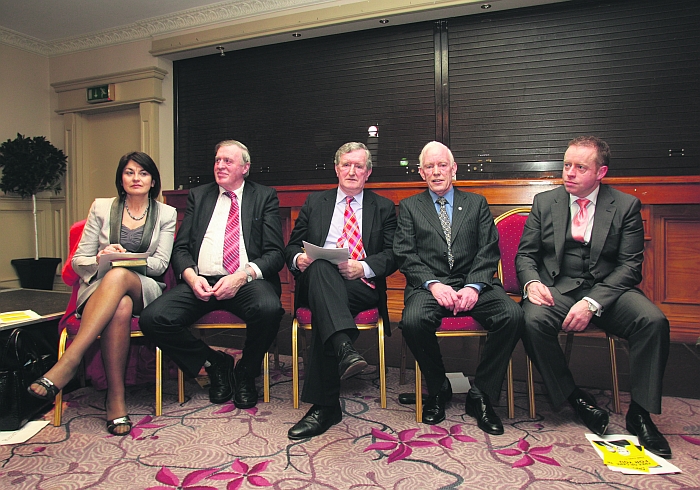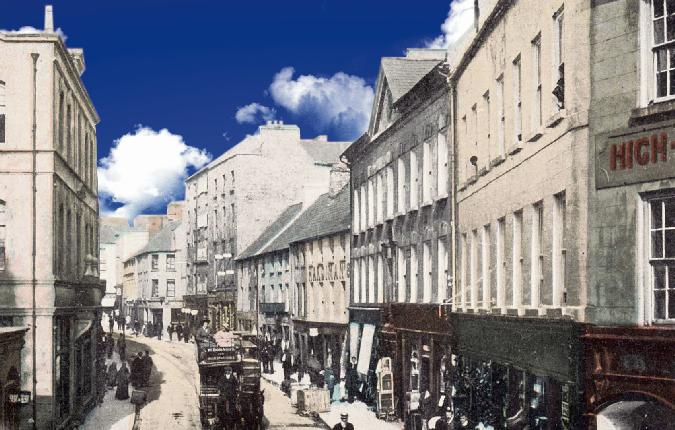Archive News
Enda opens the election campaign; and it’s one all between Fahey and Grealish

Date Published: {J}
Well, Enda Kenny could hardly have chosen a more appropriate week in which to try to convince the electorate that really they would fare better under a new health regime – with people’s minds firmly fixed on those thousands of unopened doctors’ referral letters in Tallaght Hospital.
The unopened letters may have been one way – though an extraordinarily impractical one! – of limiting the growth of the waiting lists. And one of the central planks of the Fine Gael new health policy, which is now being outlined around the country, is the elimination of those waiting lists where patients awaiting treatment now number 150,000, according to FG.
Enda Kenny and FG Health Spokesman Dr. James O’Reilly were in Galway this week as part of a nationwide campaign to outline the alternative health service which they say could be completed in five years, transforming our health system – and get action on key areas like those waiting lists, patients on trolleys in A&E units, and end the situation where in many cases, you may have to ‘go private’ if you want action on a health problem.
It all sounds like the first shots in a general election campaign in which one of the key areas will be health services. And those posters up around the county of Kenny and Dr. O’Reilly have the ‘election’ feel about them.
The new health policy is one outcome of a move in 2008 by Enda Kenny who set up a Fine Gael health commission to brain-storm on what could be done to get reform a two-tier health system – one public, one private.
Interestingly, some of the key inputs to that think-tank and the new policy came from Dr. John Barton, the Ballinasloe cardiologist who stood for FG in the 2007 General Election in Galway East, where he got almost 5,000 votes. He is one of five contenders for a nomination for FG in the next General Election in Galway East.
The country to which Enda Kenny continually points is The Netherlands. He says Fine Gael have studied health services in a number of other countries. For instance, in a 450-bed hospital he had visited in The Hague, people coming in were seen within ten minutes; the longest time you would be there, unless you had to be admitted, would be two-and-a-half hours, and, meantime, there were no patients on trolleys.
“In the Netherlands, they have a 17million population and spend €3,500 per head of population on health services. They have no waiting lists and no patients on trolleys. Here we spend almost €5,000 per head of population and have a system that simply does not deliver. I am determined to change that.
“Our changes will end the two-tier system, eliminate waiting lists, increase primary care in communities and will be based on universal health insurance for all,” the Fine Gael leader said this week.
Essentially, Kenny added, the two-tier health system meant that, if you had the money to ‘go private,’ you could be treated privately in a matter of weeks, while, if you were dependant the public system, you might wait years. The health crisis of the past week showed that if your GP referral letter happened to end up in ‘that box’ in Tallaght Hospital, you might never be reached.
Said Kenny: “I suppose there could hardly have been a week when people were more likely to respond to an initiative on health care …. though I have to say that the revelation that letters of referral weren’t even being opened, is extraordinary and utterly shocking. I only hope it was not happening elsewhere.”
Massive waiting lists were certainly at the background of most people’s minds as one of the symptoms of a health service delivery system which was sick.
For more, read this week’s Connacht Tribune.
Galway in Days Gone By
The way we were – Protecting archives of our past

People’s living conditions less than 100 years ago were frightening. We have come a long way. We talk about water charges today, but back then the local District Councils were erecting pumps for local communities and the lovely town of Mountbellew, according to Council minutes, had open sewers,” says Galway County Council archivist Patria McWalter.
Patria believes we “need to take pride in our history, and we should take the same pride in our historical records as we do in our built heritage”. When you see the wealth of material in her care, this belief makes sense.
She is in charge of caring for the rich collection of administrative records owned by Galway County Council and says “these records are as much part of our history as the Rock of Cashel is. They document our lives and our ancestors’ lives. And nobody can plan for the future unless you learn from the past, what worked and what didn’t”.
Archivists and librarians are often unfairly regarded as being dry, academic types, but that’s certainly not true of Patria. Her enthusiasm is infectious as she turns the pages of several minute books from Galway’s Rural District Councils, all of them at least 100 years old.
Part of her role involved cataloguing all the records of the Councils – Ballinasloe, Clifden, Galway, Gort, Loughrea, Mountbellew, Portumna and Tuam. These records mostly consisted of minutes of various meetings.
When she was cataloguing them she realised their worth to local historians and researchers, so she decided to compile a guide to their content. The result is For the Record: The Archives of Galway’s Rural District Councils, which will be a valuable asset to anybody with an interest in history.
Many representatives on these Councils were local personalities and several were arrested during the political upheaval of the era, she explains.
And, ushering in a new era in history, women were allowed to sit on these Rural District Councils – at the time they were not allowed to sit on County Councils.
All of this information is included in Patria’s introductory essay to the attractively produced A4 size guide, which gives a glimpse into how these Rural Councils operated and the way political thinking changed in Ireland during a short 26-year period. In the early 1900s, these Councils supported Home Rule, but by 1920, they were calling for full independence and refusing to recognise the British administration.
“I love the tone,” says Patria of the minutes from meetings. “The language was very emotive.”
That was certainly true of the Gort Rural District Council. At a meeting in 1907, following riots in Dublin at the premiere of JM Synge’s play, The Playboy of the Western World the councillors’ response was vehement. They recorded their decision to “protest most emphatically against the libellous comedy, The Playboy of the Western World, that was belched forth during the past week in the Abbey Theatre, Dublin, under the fostering care of Lady Gregory and Mr Yeats. We congratulate the good people of Dublin in howling down the gross buffoonery and immoral suggestions that are scattered throughout this scandalous performance.
For more from the archives see this week’s Tribunes here
Archive News
Galway have lot to ponder in poor show

Date Published: 23-Jan-2013
SLIGO 0-9
GALWAY 1-4
FRANK FARRAGHER IN ENNISCRONE
GALWAY’S first serious examination of the 2013 season rather disturbingly ended with a rating well below the 40% pass mark at the idyllic, if rather Siberian, seaside setting of Enniscrone on Sunday last.
The defeat cost Galway a place in the FBD League Final against Leitrim and also put a fair dent on their confidence shield for the bigger tests that lie ahead in February.
There was no fluke element in this success by an understrength Sligo side and by the time Leitrim referee, Frank Flynn, sounded the final whistle, there wasn’t a perished soul in the crowd of about 500 who could question the justice of the outcome.
It is only pre-season and last Sunday’s blast of dry polar winds did remind everyone that this is far from summer football, but make no mistake about it, the match did lay down some very worrying markers for Galway following a couple of victories over below par third level college teams.
Galway did start the game quite positively, leading by four points at the end of a first quarter when they missed as much more, but when Sligo stepped up the tempo of the game in the 10 minutes before half-time, the maroon resistance crumbled with frightening rapidity.
Some of the statistics of the match make for grim perusal. Over the course of the hour, Galway only scored two points from play and they went through a 52 minute period of the match, without raising a white flag – admittedly a late rally did bring them close to a draw but that would have been very rough justice on Sligo.
Sligo were backable at 9/4 coming into this match, the odds being stretched with the ‘missing list’ on Kevin Walsh’s team sheet – Adrian Marren, Stephen Coen, Tony Taylor, Ross Donovan, David Kelly, David Maye, Johnny Davey and Eamon O’Hara, were all marked absent for a variety of reasons.
Walsh has his Sligo side well schooled in the high intensity, close quarters type of football, and the harder Galway tried to go through the short game channels, the more the home side bottled them up.
Galway badly needed to find some variety in their attacking strategy and maybe there is a lot to be said for the traditional Meath style of giving long, quick ball to a full forward line with a big target man on the edge of the square – given Paul Conroy’s prowess close to goal last season, maybe it is time to ‘settle’ on a few basics.
Defensively, Galway were reasonably solid with Gary Sice at centre back probably their best player – he was one of the few men in maroon to deliver decent long ball deep into the attacking zone – while Finian Hanley, Conor Costello and Gary O’Donnell also kept things tight.
For more, read this week’s Connacht Tribune.
Archive News
Real Galway flavour to intermediate club hurling battle in Birr

Date Published: 23-Jan-2013
images/files/images/x3_Courthouse.jpg










